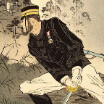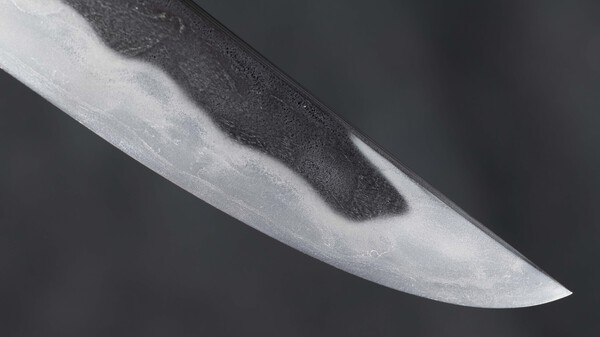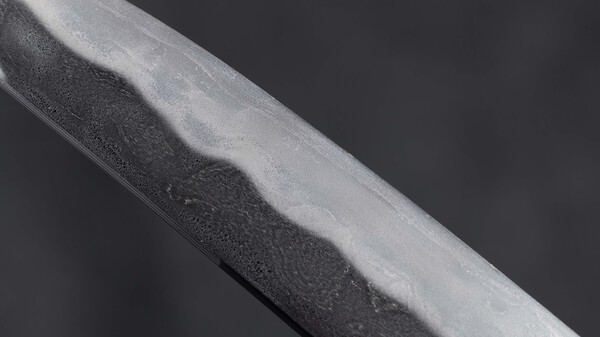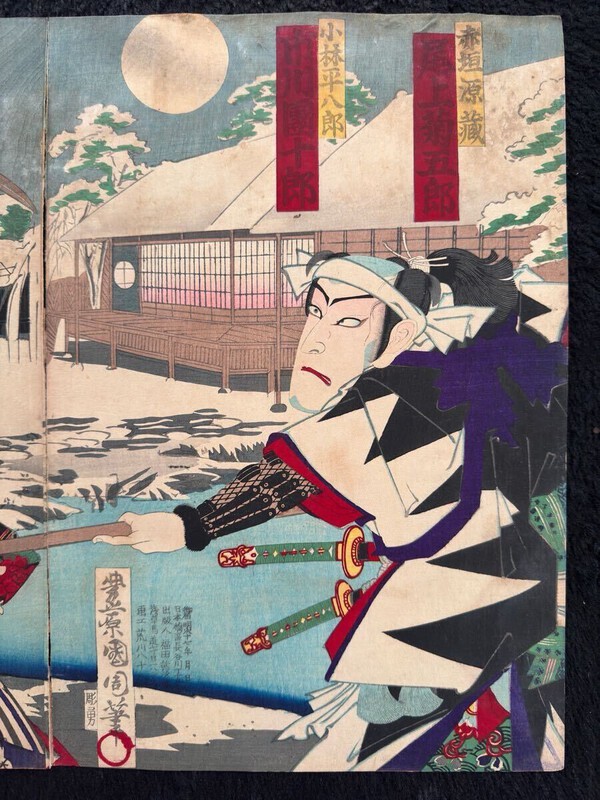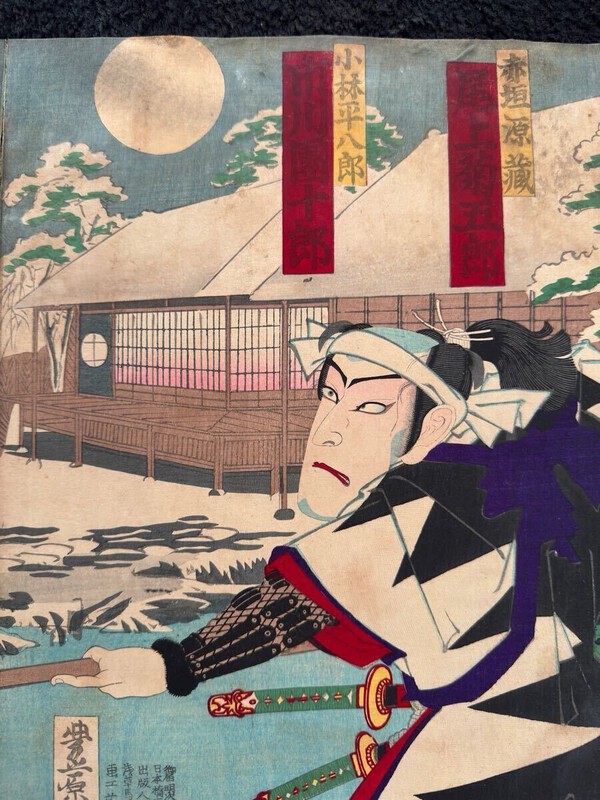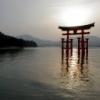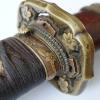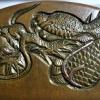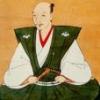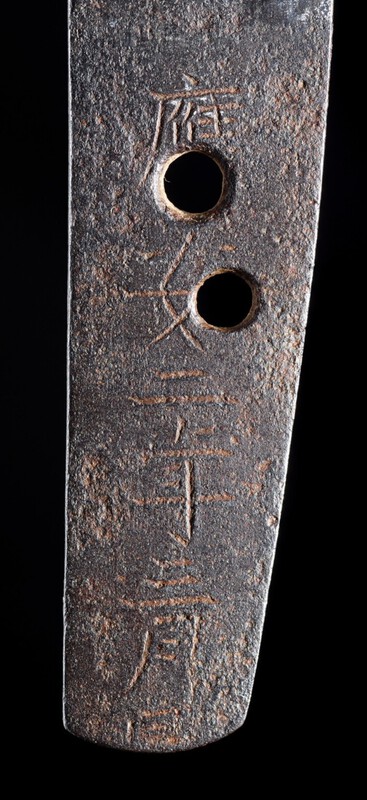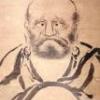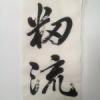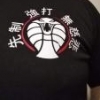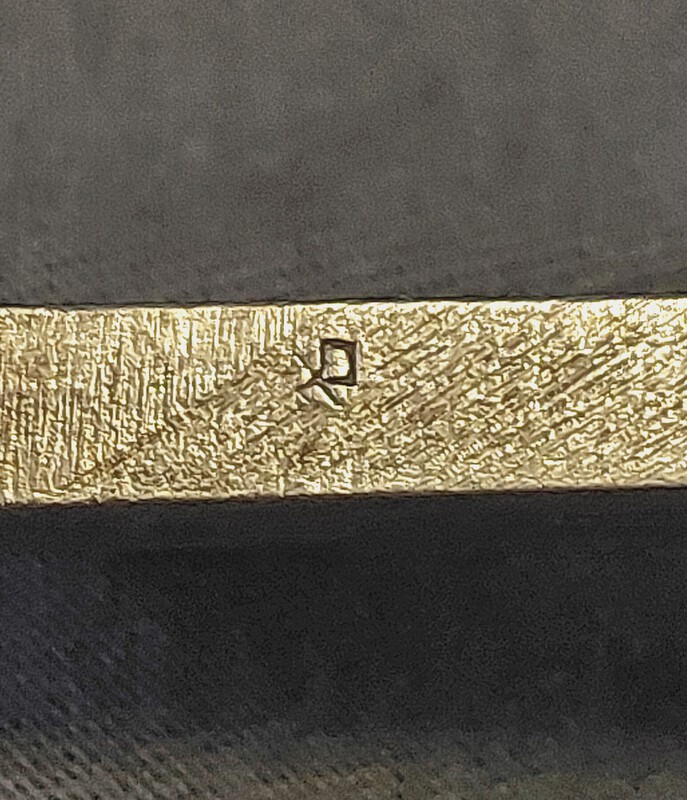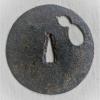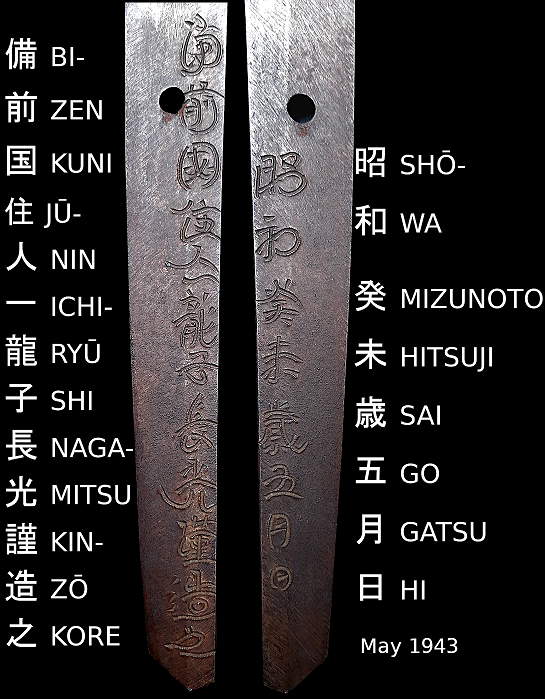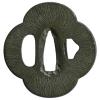Leaderboard
Popular Content
Showing content with the highest reputation on 02/17/2025 in all areas
-
14 points
-
For sale Ko-wakizashi from Hasebe school Blade passed Juyo 50 Details of the blade from setsumei Measurements nagasa 31.4 cm, sori 0.6 cm, motohaba 2.9 cm, nakago-nagasa 9.0 cm, only very little nakago-sori Description Keijo: hira-zukuri, mitsu-mune, wide mihaba sunnobi, thin kasane, shallow sori Kitae: rather standing-out itame that is mixed with mokume and nagare-masame and that features plenty of ji-nie and chikei Hamon: nie-laden and wide notare with a wide and overall rather subdued nioiguchi that is mixed with gunome, ashi, yō, kinsuji, sunagashi, and along the fukura with tobiyaki, yubashiri, and muneyaki, making this area tend to hitatsura Bōshi: on the omote side notare with a ko-maru-kaeri and hakikake at the very tip and on the ura side midare-komi with a ko-maru-kaeri which runs back in a long fashion and connects with the muneyaki Nakago: ubu, shallow kurijiri, katte-sagari yasurime, two mekugi-ana, mumei Explanation Together with the Nobukuni (信国) School, the Hasebe (長谷部) School is regarded as the most representative lineage of Yamashiro smiths of the Nanbokuchō period. Outstanding masters from this school were Kunishige (国重) and Kuninobu (国信) who focused on a hitatsura, an interpretation that emerged at that time, but also worked like here in a midareba that bases on a notare that is mixed with gunome. This wakizashi is ubu and mumei and was handed down as work of the Hasebe School. Only the area along the fukura tends to hitatsura, but is still not a full hitatsura, the composition of the ha however with prominent notare, the jigane showing a tendency towards masame, and the very thin kasane do represent the characteristic features of the Hasebe School. Supplied with shirasaya Shipped from Slovakia Price: 24k EUR (includes shipping within continental EU) + PP fee7 points
-
It doesn´t matter if it is Koto, Shinto or ShinShinto. All that matters is: it is a Japanese sword with an inscription and a fair price tag. And Dee likes it.5 points
-
Gimei is gimei and that's that. "nihonto-museum" is no valuable reference at all. And yes: Guido is a real character, always was. Sadly enough he is not able to participate anymore. As for you , "Dee", I have my doubts who you really are. Playing the "Lady-bonus" here for somebody else ? reinhard5 points
-
トキワ Tokiwa - it is a location in Tokyo (Tokiwamatsu-chō) where Shigetsugu's forge was. Near present-day Shibuya. https://ja.wikipedia.org/wiki/常磐松町4 points
-
I've always loved the story of the 47 Ronin and one of the most memorable scenes in the movie version I watched as a kid was of one samurai facing off against two of the ronin and almost beating them to a standstill. So I was delighted to pick up the following triptych, again at a pittance compared to what dealers in the States would charge me for a single sheet.4 points
-
Not sure you know exactly what you are looking for. Mantetsu swords are purchased for their history and as militaria. They certainly aren't bought for their artistic traits. They don't exhibit nice hataraki or interesting hamon. They are arsenal swords, but made using certain techniques that increased their useability. Whether it's cleaned a bit or not isn't the prime factor in owning one of them. If you are looking for a nice WW2 sword with interesting hamon and showing hada/hataraki, then Mantetsu swords aren't where you should be looking. What were you expecting of this sword? It's a factory, not a particular smith. This is like buying a Type 95 Gunto and then lamenting that it doesn't have a nice polish or hamon.4 points
-
Back to the main topic… I have 2 gimei blades. First is a Hizen Tadahiro signed katana but deemed gimei by NTHK-NPO, but still judged as a Hizen blade of same approximate time period as Tadahiro with exact same workmanship. Second blade is an Awataguchi Tadatsuna wakizashi deemed gimei by NTHK, but still judged as a lower level student of Tadatsuna and blade exhibits typical Awataguchi traits. So if you want to study schools and activity, and aren’t worried about who you show it to or the naysayers, I have no problem with gimei… especially at a fraction of the price.4 points
-
The Tadahiro I bought without papers. The mei was sketchy, but it did come with a Kanzan Sato sayagaki. I was given some advice by some well known people in the field who felt it was gimei and when I submitted for papers it was also deemed gimei so it did not come as a surprise. A couple of the people who advised me did say something along the lines of “you can see why whoever added the gimei signature chose this blade… it was a clear Hizen blade and it would be easier to pass as a Tadahiro”. Now, the sayagaki? Three choices… 1) sayagaki is gimei, 2) someone matched this blade to a different signed saya, or 3) Kanzan Sato got this one wrong. The Tadatsuna blade I bought with the pink paper. Seller did not try to hide the fact blade was gimei. I still liked the blade and it was an example of a Awataguchi blade I could study in hand. It wasn’t perfect or the best example, but it was nice and I liked it.3 points
-
Dear fellows collectors, I'd like to share with you the sword I've just brought home. She's a Kaneshige blade made in feb 1944 (and thanks to the members here that translated properly the nakago in my previous post). I apologize for the low quality pics, but I have to say that these objects are pretty hard to photograph.2 points
-
2 points
-
2 points
-
Not a new member... But I changed my username from GeorgeLuucas to Scogg Scogg is an abbreviation of my last name, and has also been a common nickname for me. I am sick being called George. Although I remain a big StarWars fan Cheers, -Sam2 points
-
2 points
-
I dont see Shinshinto, not with the nakago and worn horimono.2 points
-
If you are in Tokyo ‘at the end of the month’, I would recommend the antique market in Kawagoe, which always takes place on the 28th of the month. I've already been to a few flea markets in Kyoto, Tokyo and the surrounding area, but I've never discovered any really nice tsuba (at least for my taste). Once there were really better pieces to be found at a dealer, but I could have bought them in Ginza for the prices they were asking. And that's how I've done it so far, by buying from the well-known dealers in their shops. You have the advantage of being able to compare favourites directly, and you usually get a discount if you pay cash.2 points
-
Well put, Dee! I'm a little late, but I would say when it comes to actual high quality blades or well known smiths, it's a bit hard to keep out of the limelight, regardless if someone inadvertently draws attention to it. As well, we know FleaBay can be a minefield, but I'm sure we all skim across it in search of a treasure and by that, if one knowledgable person sees something, you can guarantee others do, as well! Short story, I was on GunBroker last year looking at Walther PPs just to pass some time, and saw an RSHA issued model. Won't go into details, but the organization was a part of the SS, not the Waffen-SS though, and about 6,000 were contracted to them. Main details are a serialized slide prior to it being put on all, and matching magazines if you're lucky to find them. About 5% are known to exist. I thought I was going to get a deal, since it wasn't labeled as that contract model, but I ended up in a bidding war with the most knowledgeable person on Walther PP/PPk variants. I ended up getting it for a decent price, though not a bargain. I took a risk since they didn't show any details on the mags, but when I picked it up, it ended up having one of the matching magazines. While I am a collector, and had been looking for one of these for as long as I was first able to buy handguns, I'm a shooter foremost, so will end up selling it. But I'm happy the hunt is over and was able to put out the information so it can be listed in the database for known surviving models for all to see. Hopefully the other mag is out there so the future owner can add it.2 points
-
you could buy one from Grey for less https://japaneseswor...ck-dragon-residence/2 points
-
It was a nice run gents, but I didn't expect it going for a final 6.5k bid, that's one happy seller2 points
-
Most curious, yes. I suppose the added hitsu must have been very slight, for the three elements that you refer to, Piers, are all pretty similar in size and shape, so it doesn't seem that adding the hitsu affected these much, if at all. Most likely, the added hitsu merely intruded on the seppa-dai slightly. Here is another piece I am puzzling over as regards the motif elements. The one on the left is similar to that in the tsuba above, but is missing the three extra elements. In this piece, I am reminded of a carpenter's planer, such as that seen here: https://www.jauce.com/auction/q11728731182 points
-
Sadly I have to agree with the opinions here. The signature too is typical for one of these netsuke-like-objects (NLO). Remember, though, if you did not pay too much for it, you can actually use one of these to hang something from without fear of damaging it, and many people will even compliment you on it! One word of caution regarding the person who sold this to you. It is possible that they did not know much when they bought it, accepting whatever they were told, and happy to make a buck. Not all dealers are experts, most are still learning on the job, and some (not all) are even happy to be educated. A few years back I bought a neat little dragon Netsuke, but when I took it home for a really good look some faint mould lines between the legs showed that it was pressed resin. A month later I took it back to the same monthly market, and the dealer was more than happy to give my money back. Mr Maehata, salute! We've been good friends ever since and I have bought several things from him subsequently.2 points
-
Nice detective work Jussi. And just for continuity, here are the Mei and nengo for the blade in the National Museum. While I generally agree with you Jussi that gimei should be left, I think in this case the kanji could be removed and then have it papered. I'd be curious as to who/school gets the attribution.2 points
-
Thanks, guys. Appreciate it. I don't know that this reading of the motif is correct (seems like quite a reach -- even the kuruma/wheel sukashi is dubious), but many thanks for the replies.2 points
-
So far I have found 6 signed tantō by Kinjū. 2 of them are dated, both share same date of Ōan 2 (1369). However the tantō that was also posted above that is featured in Kantō Hibishō by Kunzan in Tōken Bijutsu 274. I just checked the magazine and I believe in there Kunzan raises questions about the authencity of the mei and date, and states that if genuine it is work of 2nd generation. The 2nd one is in the collection of Kyoto National Museum https://knmdb.kyohaku.go.jp/29675.html I agree with Jacques that I personally don't consider only old oshigata as very reliable info. They can be very nice supplement but I require modern information to satisfy my data needs.2 points
-
Hi Steve, Namako ni kuruma sukashi - sea cucumber and wheel.2 points
-
2 points
-
Biggest in Tokyo is Oedo Sunday Market at the Tokyo International Forum - Yurakucho Station 1st stop on the JR Yamanote after JR Yamanote Tokyo Station 1st and 3rd Sundays weather permitting. https://www.antique-market.jp/english/ And definitely echo what Brian said about prices and origin of some items.2 points
-
They do, Gerry - until it's something they want to buy. Then it's 'full stealth mode' and every man for himself. 😉 "All's fair in love, war and swords."2 points
-
1 point
-
Hi boys and girls while watching the sale of the katana by Kasama Shigetsugu today on eBay it got me thinking why some of Shigetsugu’s swords forged on the estate of Tōyama Mitsuru have an inscription stating made on the estate of the venerable Tōyama Mitsuru while other swords forged by Shigetsugu on the estate have the hot stamp of Tōyama Mitsuru ,were these swords made as gifts? Did other smiths who forged swords there use this stamp as well ,Curious to here your thoughts some pics of the hot stamp. cheers Chris H1 point
-
1 point
-
1 point
-
1 point
-
The Japanese write that 'Kantei is the foundation for Japanese sword appreciation.' They are correct in every sense. 'Forgive them for they know not what they do.' Principles.pdf https://www.pbs.org/...hailand/buddhism.htm1 point
-
Thank you, Conway. I've actually combed through dozens of seal script charts and web sites and read through Markus Sesko's book on seal scripts. So far, I have only found a few direct matches to the radicals in the scripts. I think they used their own version of the radical rather than a standard, in some cases (I even checked the Chinese versions). Another issue is that when I do decipher a seal script and find the corresponding kanji, I still can't read the meaning (see the Translation section for an example). John C.1 point
-
1 point
-
You did well. It's better than most Kinju I've seen. If it was Kinju, it would most likely express the rather regular gunome hamon in nie deki. This work is more interesting. It is aiming for Norishige school. There is conspicuous chickei, sunagashi, and rather coarse ara-nie. The relatively coarse ara-nie, thick kasane, and somewhat 'contrived' quality of the chickei does rather speak towards Shinshinto work that tries hard to emulate Koto. I think, with the signature, it was probably an entire package made with the intention to mislead. However... There is a chance that it is a healthy Koto piece. The photos doesn't show everything unfortunately, but I wouldn't rule out Tametsugu here if the work was mumei. In any case, to me, this is more exciting than some Kinju. Buying a Gimei blade? No, not a full blown gimei, not today. When I started, then certainly yes. As it stands in 2025, my limit would be "To mei ga aru" if the piece showed remarkable qualities. I like research pieces.1 point
-
that indeed looks nice from the pictures, I could hardly imagine how it looks in person. its obviously better of in a shirasaya. A gimei without a shirasaya but papered koshirae is called a deluxe tsunagi1 point
-
I totally forgot to reply to this incredibly informative and helpful post. I really appreciate it! My apologies, Kirill.1 point
-
Gray, this looks like a (heavily damaged) WAKIZASHI (not wakazashi), and it has nothing to do with WWII. Although it is in bad condition, it should NEVER rest on concrete or any other hard surface.1 point
-
1 point
-
IMO that downvote is harsh. @Gerry obviously thought he was doing the majority a favor, rather than a minority a disservice. There are no rules on here - as far as I'm aware - to stop members showing any public listing for any reason. Just sayin' Dee1 point
-
1 point
-
Dating anything that is not recorded, dated or present in archaeology, is rife with difficulty. Often the only clues we have are in the style, motif, construction methods/techniques and materials. All of which are further confused by opinions/information that that has been disseminated and repeated by well meaning experts without sufficient evidence.1 point
-
Rock Island protects themselves by using the word "style" in the description, like "Japaese style sword", "Japanese style NCO sword" ect.1 point
-
I think the seller should accept some responsibility for selling fake/forged/inaccurately described items. We condemn the poor buyer for buying this stuff. But he/she is simply relying on the opinion of the auction house. In other words, the buyer trusts the seller's assessment because we can't be experts at everything. Personally, I don't blame the victim for getting duped by, what is supposed to be, a trusted source. I think the auction site should be held criminally and/or financially liable. John C.1 point
-
1 point
-
Thanks John! Wow, that Russian site has quite a collection! Here's another kaigunto with mon on THIS PAGE.1 point
-
1 point
This leaderboard is set to Johannesburg/GMT+02:00

